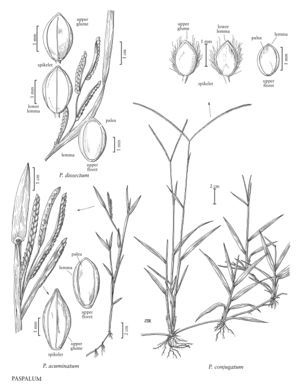Paspalum dissectum
Plants perennial; rhizomatous. Culms 10-50 cm, decumbent; nodes glabrous or pubescent. Sheaths glabrous; ligules 2-2.5 mm; blades to 12 cm long, 1.3-4.8 mm wide, flat. Panicles terminal, with 2-6 racemosely arranged branches; branches 1.3-5.3 cm, diverging to erect, often arcuate, persistent; branch axes 1.8-3 mm wide, broadly winged, usually conduplicate, glabrous, margins scabrous, terminating in a spikelet. Spikelets 1.7-2.1 mm long, 1.1-1.4 mm wide, solitary, appressed to the branch axes, elliptic to ovate, glabrous, stramineous. Lower glumes absent; upper glumes and lower lemmas 5-veined; upper florets stramineous, lemmas glabrous throughout. Caryopses 1-1.3 mm, white. 2n = 40, 60.
Distribution
Md., N.J., Tenn., Okla., Miss., Tex., La., Mo., Del., Ala., D.C., Kans., N.C., S.C., Va., Ark., Ill., Ga., Ky., Fla.
Discussion
Paspalum dissectum grows at the edges of lakes, ponds, rice fields, and wet roadside ditches. It is native to the eastern portion of the contiguous United States and to Cuba.
Selected References
None.
